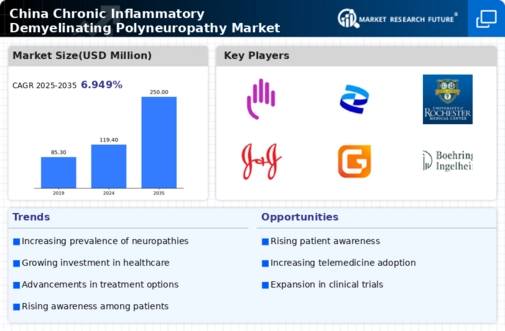Growing Awareness and Education
Increasing awareness and education regarding chronic inflammatory-demyelinating-polyneuropathy among healthcare professionals and the general public is a significant driver for the market. Educational initiatives aimed at improving understanding of the disease, its symptoms, and treatment options are essential for early diagnosis and intervention. As healthcare providers become more knowledgeable about chronic inflammatory-demyelinating-polyneuropathy, they are better equipped to recognize and treat the condition effectively. This heightened awareness is likely to lead to an increase in patient referrals and treatment uptake, thereby expanding the chronic inflammatory-demyelinating-polyneuropathy market. Furthermore, public awareness campaigns can encourage individuals to seek medical advice sooner, contributing to improved health outcomes.
Government Initiatives and Funding
Government initiatives aimed at improving healthcare infrastructure and funding for neurological research are pivotal for the chronic inflammatory-demyelinating-polyneuropathy market. In recent years, the Chinese government has increased its investment in healthcare, with a focus on neurological diseases. This includes funding for research and development of new therapies, as well as initiatives to enhance patient access to existing treatments. Such support is likely to foster innovation within the chronic inflammatory-demyelinating-polyneuropathy market, encouraging pharmaceutical companies to invest in new drug development. Additionally, public health campaigns aimed at raising awareness about neurological disorders may lead to increased diagnosis and treatment, further propelling market growth.
Advancements in Diagnostic Technologies
Technological advancements in diagnostic tools are significantly impacting the chronic inflammatory-demyelinating-polyneuropathy market. Enhanced imaging techniques and biomarker identification have improved the accuracy and speed of diagnosis, allowing for earlier intervention. For instance, the introduction of high-resolution MRI and electrophysiological testing has facilitated better detection of chronic inflammatory-demyelinating-polyneuropathy, which is critical for effective treatment planning. As diagnostic capabilities improve, healthcare professionals can provide timely and appropriate therapies, which may lead to better patient outcomes. This trend is likely to drive market growth as more patients are diagnosed and treated effectively, thereby increasing the overall demand for chronic inflammatory-demyelinating-polyneuropathy therapies in China.
Rising Demand for Effective Treatment Options
The chronic inflammatory-demyelinating-polyneuropathy market is experiencing a surge in demand for effective treatment options. Patients and healthcare providers are increasingly seeking therapies that not only alleviate symptoms but also address the underlying causes of the disease. This demand is driven by the limitations of existing treatments, which may not provide satisfactory outcomes for all patients. As a result, pharmaceutical companies are focusing on developing novel therapies, including biologics and immunotherapies, which show promise in managing chronic inflammatory-demyelinating-polyneuropathy. The market is likely to benefit from this trend, as innovative treatment options become available, potentially improving patient quality of life and driving market expansion.
Increasing Prevalence of Neurological Disorders
The rising incidence of neurological disorders in China is a crucial driver for the chronic inflammatory-demyelinating-polyneuropathy market. Recent studies indicate that the prevalence of chronic inflammatory-demyelinating-polyneuropathy has been increasing, with estimates suggesting that approximately 2-5 cases per 100,000 individuals are diagnosed annually. This growing patient population necessitates enhanced healthcare services and treatment options, thereby stimulating market growth. Furthermore, as awareness of neurological conditions improves, more patients are likely to seek medical attention, leading to increased demand for therapies and interventions. Thus, the chronic inflammatory-demyelinating-polyneuropathy market is positioned to expand as healthcare providers adapt to the needs of this rising demographic. This adaptation may lead to innovations in treatment methodologies and patient care.
























Leave a Comment